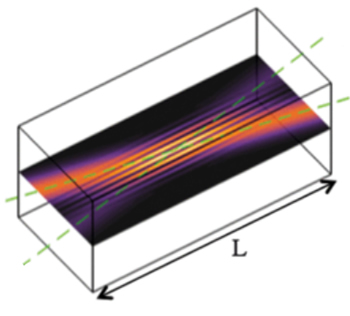Papers and Presentations - 2016
May
Toward a High-Energy Laser-Plasma Optical Device
New Insights into Glass Polishing
In a continuing quest to understand the complex nature of glass polishing, a team of LLNL researchers has used an atomic force microscope (AFM) to mimic the mechanical removal of material by a single polishing particle on a surface being polished. The research was featured in the cover article of the May 2016 issue of the Journal of the American Ceramic Society.

The team used a 150-nanometer-radius diamond-coated AFM tip to make nanoscratches in both air and aqueous environments on polished fused silica, borosilicate, and phosphate glass surfaces. The topologies of the nanoscratches were then characterized with the AFM.
Nanoscratching in air generally showed deeper and narrower scratches with more “pileup” compared to nanoscratching in water, especially on fused silica glass. For phosphate glass, the load dependence of the removal depth was consistent with that expected from the standard theoretical description of the process.
For fused silica and borosilicate glass, however, the deformation depth showed only a weak dependence with load. Using a combination of techniques, the team was able to define a composite removal function (removal depth) for a single polishing particle as a function of load. This removal function will serve as important input for understanding and predicting material removal rate and roughness during glass polishing.
Members of the LLNL team were Nan Shen, Tayyab Suratwala, William Steele, Lana Wong, Michael D. Feit, Philip E. Miller, Rebecca Dylla-Spears, and Richard Desjardin. The work was funded by the Laboratory’’s Laboratory Directed Research and Development program.
Toward a High-Energy Laser-Plasma Optical Device
A recent experiment conducted on the Janus laser at LLNL’s Jupiter Laser Facility has established the feasibility of photonic devices based on the interaction of a laser and a plasma—a medium consisting of freely moving ions and free electrons—that are ultrafast, more damage-resistant than conventional optics, and easily tunable.
In a Physical Review Letters paper published online on May 18, LLNL researchers and colleagues reported on the first experimental demonstration of a high-power plasma wave plate, a device used to modify the polarization, or electric-field orientation, of an independent probe laser beam.
 Design of a laser-plasma wave plate.
Design of a laser-plasma wave plate. In the experiment, the laser-plasma wave plate converted an elliptically polarized laser beam into a nearly ideal circularly polarized beam by varying the laser’s pump intensity and the plasma density. “This demonstrates the potential for high-power, tunable laser-plasma photonic devices,” the researchers said. ”Plasma-mediated polarization control enables more sophisticated manipulation of light at fluences millions of times greater than those withstood by traditional (crystal-based) optics.”
Along with demonstrating the feasibility of entirely plasma-based laser devices, the researchers said the experiment has implications for existing experiments that employ multiple crossed laser beams, such as inertial confinement fusion (ICF) and high energy density (HED) experiments on NIF (see “Controlling Laser Beam Polarization in Plasma”).
“One (implication) is that the polarization change induced in a probe beam by a crossing pump can be used to diagnose plasma conditions,” they said. “Another is that a certain amount of polarization smoothing, with benefits such as reduced laser-plasma instability growth and less laser self-focusing, is intrinsic to situations in which multiple laser beams cross at arbitary angles in plasma, such as in the laser entrance holes of indirect-drive inertial confinement fusion hohlraums. This may also mean that polarization alteration could impact the modeling of crossed-beam energy transfer in both indirect- and direct-drive ICF.”
Lead author David Turnbull was joined on the paper by LLNL colleagues Pierre Michel, Tom Chapman, Bradley Pollock, Clement Goyon, Steven Ross, Laurent Divol, and John Moody and by collaborators from the York Plasma Institute at the University of York in the UK and the School of Electrical and Computer Engineering at Cornell University.




